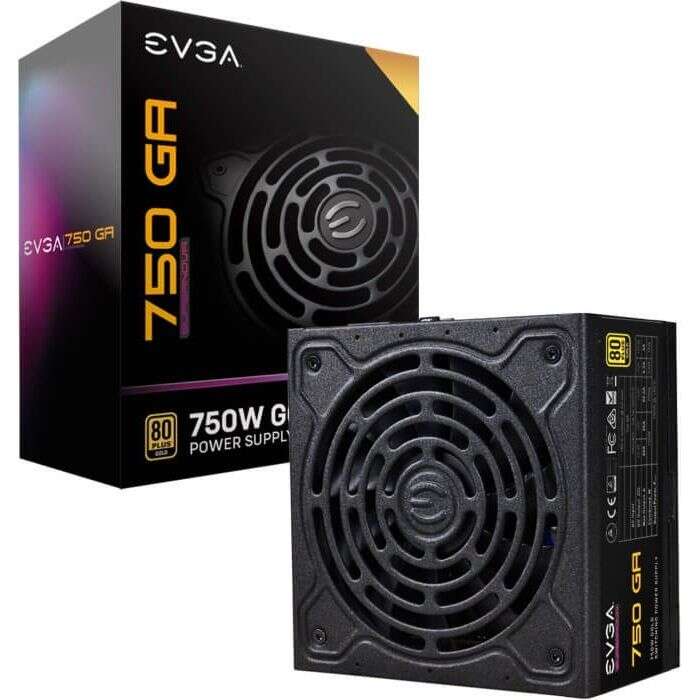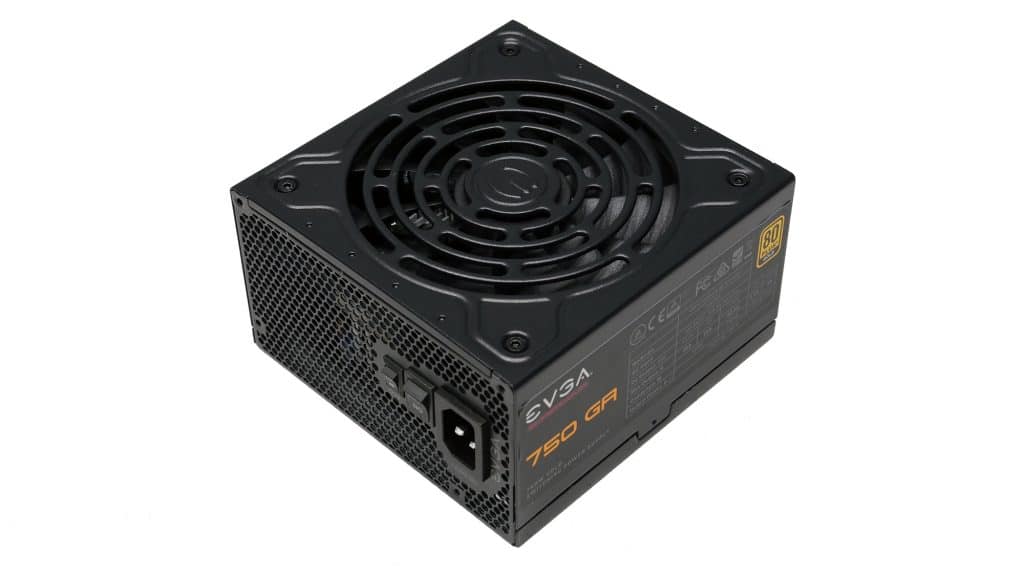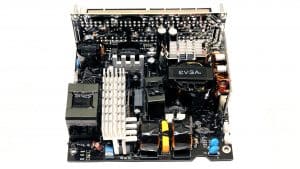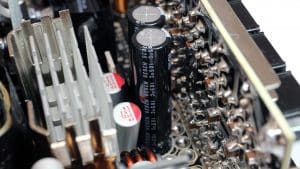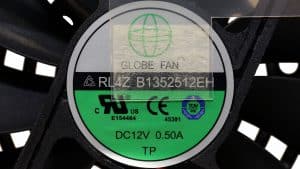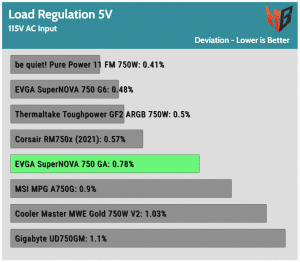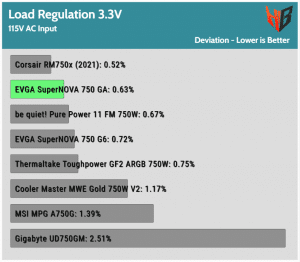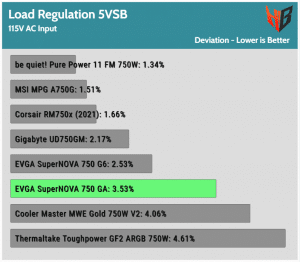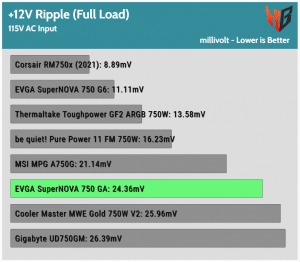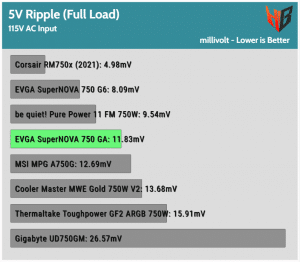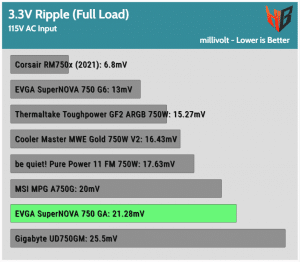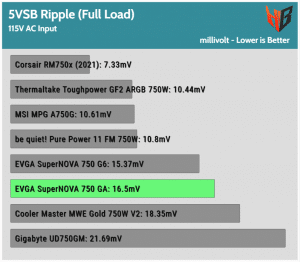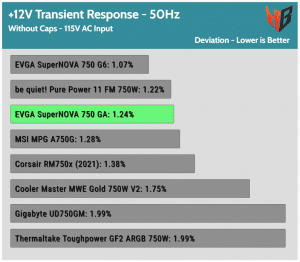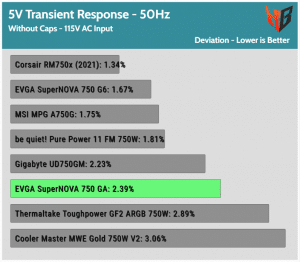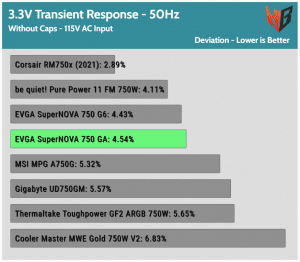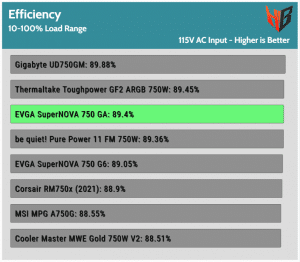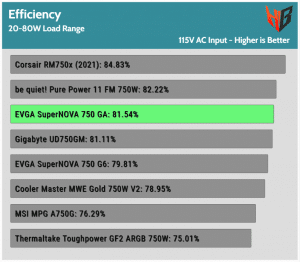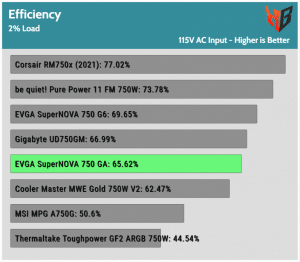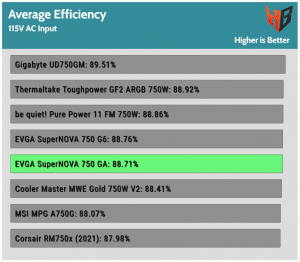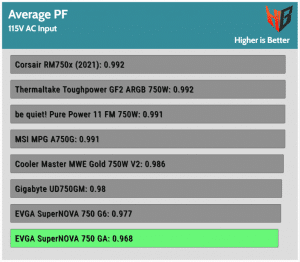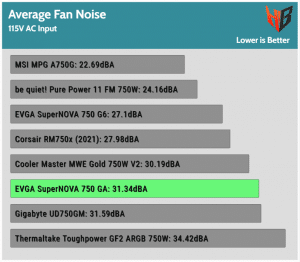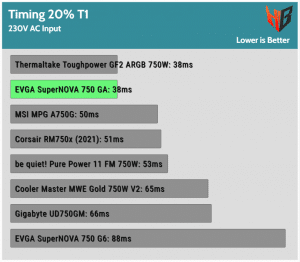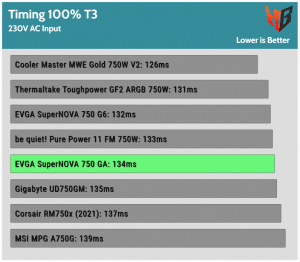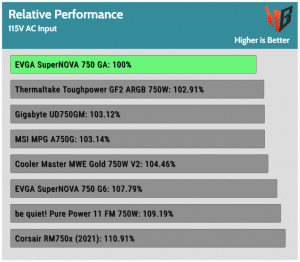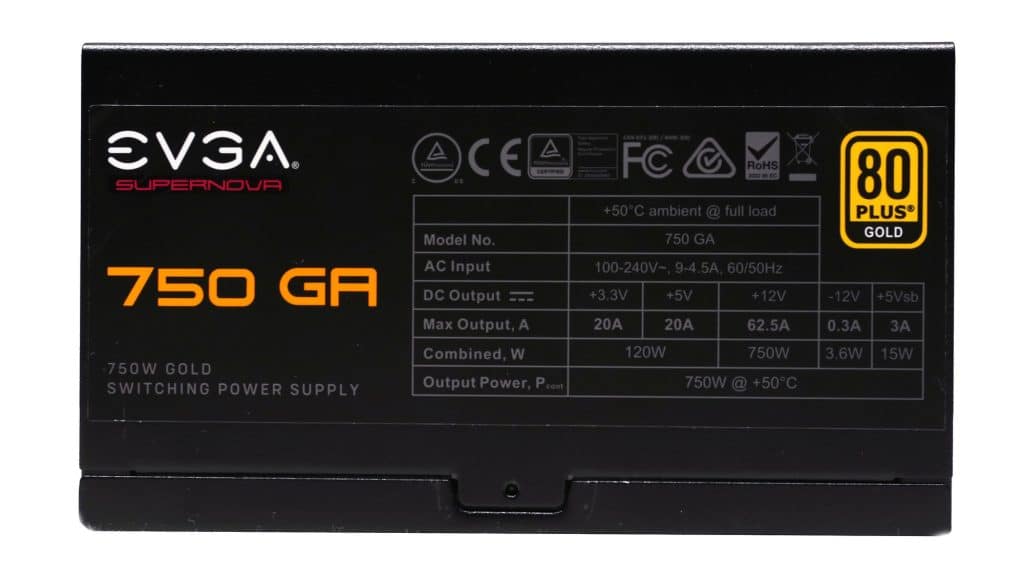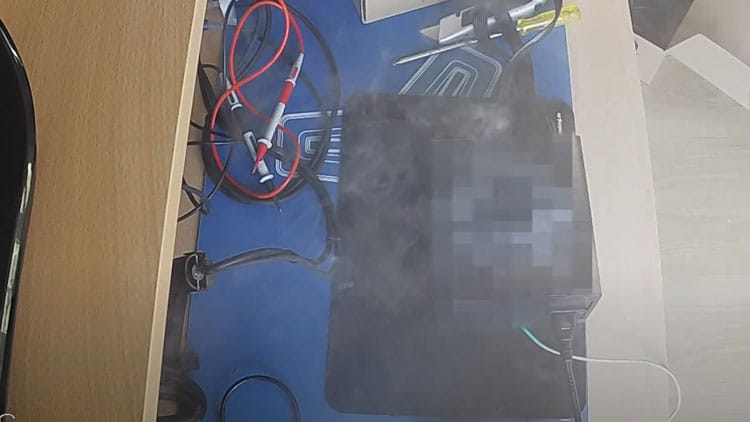EVGA has countless PSU lines, creating confusion not only to users, but even to expert reviewers. The SuperNOVA━this name always brings a smile in my face since we are talking about a PSU━GA has 4.8 out of 5 stars on Amazon.com, with close to 1500 reviews, so it looks a good PSU, provided at a low price. Given the Gold efficiency, the fully modular cable design, the double ball-bearing fan and the ten year warranty, the 80 dollar price tag is sweet!
EVGA’s SuperNOVA GA line was introduced in late 2019, and so far, I didn’t have the chance to review one of them. The line consists of four members with capacities ranging from 550W to 850W. In today’s review, I will take a look at the second strongest unit, with 750W max power output and a 50°C temperature rating for continuous full power output! Not many PSUs, even some high-end ones, have a 50°C rating for full load, so I will push this PSU to the max, and hopefully, I won’t encounter any supernovas!
Cybenetics Report- Manufacturer (OEM): Andyson
- Max Power: 750W
- Efficiency: Cybenetics Silver (85-87%), 80 PLUS Gold
- Noise: Cybenetics S++ (30-35 dB[A])
- Form Factor: ATX12V v2.53
- Alternative Low Power Mode support: ✓
- Power 12V: 750W
- Power 5V + 3.3v: 120W
- Power 5VSB: 15W
- Cooling: 135mm Double Ball Bearing Fan (RL4Z B1352512EH)
- Modular Design: Yes (Fully)
- Connectors: 2x EPS, 6x PCIe 6+2 pin (on 3x cables)
- Dimensions (W x H x D): 150 x 85 x 150mm
- Warranty: 10 years
| Protection Features | |
| OCP (Cold @ 22.5°C) | 12V: 100.02A (160%), 12.131V 5V: 25.4A (127%), 4.969V 3.3V: 30.2A (151%), 3.296V 5VSB: 6.8A (226.7%), 4.857V |
| OCP (Hot @ 36°C) | 12V: 100.39A (160.62%), 12.135V 5V: 25.3A (126.5%), 4.971V 3.3V: 29.9A (149.5%), 3.299V 5VSB: 6.8A (226.7%), 4.822V |
| OPP (Cold @ 21°C) | 1213.38W (160.03%) |
| OPP (Hot @ 38°C) | 1218.27W (160.62%) |
| OTP | ✓ (140°C @ 12V Heat Sink) |
| SCP | 12V to Earth: ✓ 5V to Earth: ✓ 3.3V to Earth: ✓ 5VSB to Earth: ✓ -12V to Earth: ✓ |
| PWR_OK | Accurate but lower than 16ms |
| NLO | ✓ |
| SIP | Surge: MOV Inrush: NTC Thermistor |
OCP triggering points are set high on the 12V rail, and the over power protection is set crazy high. This can be a problem if users push the PSU hard under high temperatures. It won’t survive, most likely, and this is a shame because OCP and OPP are supposed not to allow users to break, easily at least, their PSUs. Moreover, OCP at 3.3V is set too high for no reason. The 5VSB rail can also deliver more than double its official current rating.
Parts Description
| General Data | – |
| Manufacturer (OEM) | Andyson |
| PCB Type | Single Sided |
| Primary Side | – |
| Transient Filter | 4x Y caps, 2x X caps, 2x CM chokes, 1x MOV |
| Inrush Protection | NTC Thermistor SCK205R0 (5 Ohm) & Relay |
| Bridge Rectifier(s) |
2x
|
| APFC MOSFETs |
2x Infineon IPP60R099P7 (600V, 20A @ 100°C, Rds(on): 0.099Ohm)
|
| APFC Boost Diode |
1x CREE C3D08060A (600V, 8A @ 150°C)
|
| Bulk Cap(s) |
1x Nichicon (400V, 560uF, 2,000h @ 105°C, GG)
|
| Main Switchers |
4x
MagnaChip MDF18N50 (500V, 11A @ 100°C, Rds(on): 0.27Ohm) |
| APFC Controller |
Champion CM6500UNX
|
| Resonant Controller | Champion CM6901T6X |
| Topology |
Primary
side: APFC, Full-Bridge & LLC converter Secondary side: Synchronous Rectification & DC-DC converters |
| Secondary Side | – |
| +12V MOSFETs | 4x Infineon IRFB7440PbF (40V, 122A @ 100°C, Rds(on): 2.5mOhm) |
| 5V & 3.3V | DC-DC Converters: 6x Nexperia PSMN4R0-30YLD (30V, 67A @ 100°C, Rds(on): 4mOhm) PWM Controller(s): ANPEC APW7159C |
| Filtering Capacitors | Electrolytic: 2x Nichicon (2-5,000h @ 105°C, HD), 4x Rubycon (4-10,000h @ 105°C, YXJ), 4x Rubycon (6-10,000h @ 105°C, ZLH), 1x Nichicon (4-10,000h @ 105°C, HE), 1x Nichicon (5-6,000h @ 105°C, HV) Polymer: 16x FPCAP |
| Supervisor IC | IN1S429I-DCG |
| Fan Model | Globe Fan RL4Z B1352512EH (135mm, 12V, 0.5A, Double Ball Bearing Fan) |
| 5VSB Circuit | – |
| Rectifier |
1x 100R25C SBR & 1x IPS ITU02N70A FET
|
| Standby PWM Controller | ATK AT6002H |
| -12V Circuit | – |
| Rectifier |
1x STMicroelectronis L7912CV (-12V, 3mA)
|
The OEM of this unit is Andyson, which I don’t often meet in my reviews. This OEM is capable of creating good products under the proper guidance. The PCB is small and overpopulated. The heatsinks are of medium size, and the build quality is high. EVGA uses high-quality caps, and the cooling fan uses double ball-bearings, so it won’t have a problem at high temperatures. It won’t be as quiet, though, as an FDB fan, but in general, DBB fans are of higher quality.
Load Regulation
Load regulation is tight on all rails, but 5VSB where it doesn’t matter much.
Ripple Suppression
Ripple suppression is not among the top in this category, but it is pretty good on most rails. The 3.3V rail’s ripple could be lower to allow for higher overall performance.
Transient Response
Transient response at +12V is not below 1%, but you cannot call it mediocre. It could be better on the other rails, though.
Hold Up Time
The hold-up time measurements show that this unit belongs to the mid category and not the high-end one, where lower than 17ms is not acceptable. Normally, every PSU compatible with the ATX spec should have over 17ms hold-up time, but bulk caps are expensive.
Inrush Current
Inrush current is low with 115V, but this is not the case for 230V input, where I measured close to 89A.
Efficiency Measurements
The unit achieves high efficiency levels with 115V input but loses ground with 230V input in the 20-100% load range. Lastly, it achieves over 60% with a 2% load, but it is far away from the recommended 70% threshold.
Average Efficiency
The average efficiency is decent. As you can see, the explosive Gigabyte UD750GM tops the chart.
Average Efficiency 5VSB
The 5VSB rail is highly efficient.
Average PF
The APFC converter needs tuning for high power factor readings.
Average Noise
Average noise is not high, but it would be nice if it were below 30 dBA.
Timings
The PSU supports Alternative Low Power Modes, which the ATX 3.0 spec requires.
Overall Performance
The overall performance takes a large hit because of the low hold-up time. Ripple suppression at 3.3V also plays a role. That said, the last position in this graph is not indicative of this unit’s worth because this chart doesn’t consider the build quality. On the other hand, it also doesn’t into account the lousy protection feature settings at 12V.
Epilogue
I didn’t expect such high build quality on the EVGA SuperNOVA 750 GA, so this was a nice surprise. Andyson, the OEM behind this unit, can make good products (e.g., the Aerocool Project 7 units), but its engineers need guidance. With properly set protection features and a longer hold-up time, and why not, lower ripple at 3.3V, this unit would achieve a competitive overall performance score. I should not forget the APFC converter, which needs tuning for higher PF readings. That said, the 750 GA is a bargain at 80 dollars, given its build quality, the fully modular cable design, and the ten-year warranty. The cherry-on-top isn’t noisy, which is usually the case in PSUs from not so known OEMs. The major downside of EVGA products is that they are so many, creating confusion for potential buyers. I can fully understand that putting all of your eggs in one basket is not good, but having dozens of baskets doesn’t make any sense, either.
Buy it here- Full power at 47 degrees Celsius
- Good build quality
- Efficient
- Tight enough load regulation
- Decent ripple suppression
- Highly efficient 5VSB rail
- Low inrush current with 115V
- Two EPS and six PCIe connectors
- DBB fan
- Compatible with the alternative sleep mode
- 10-year warranty
- OCP at 12V and OPP are set sky-high!
- Low hold-up time
- Not competitive overall performance
- High inrush current with 230V
- Not so high PF readings
- Short distance between the peripheral connectors
